| In the year 1502, more than a
century before the Pilgrims landed on Plymouth Rock,
while Henry VII, first son of The House of Tudor, ruled
over Britain, the existence of the great Amazon was
discovered. That was more than four centuries ago. Today the potentialities of the
Amazon River and its incomparable basin of some 2,722,000
square miles - over twice the estimated drainage area of
the Mississippi and its combined tributaries - is still a
vast region of undiscovered treasure. As the years
progress chemistry will find uses for the myriad of plant
species indigenous to the Amazonian basin; engineers will
harness the untold horsepower of energy, and have, for
centuries, wasted themselves in their journeys through
the virgin jungles to the sea; botanists, biologists, and
ornithologists will enrich their sciences with
discoveries in regard to the flora and the fauna of the
Amazonian tropics; and among other phenomena to be
studied archeologists may analyze the earthly lamina of
this "great unknown" to solve mysteries
predating those of the pre-Columbian era. In the fields
of science the Amazon River is still a vast virgin world
in itself, awaiting exploration and exploitation in the
light of modern advancements. 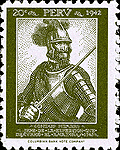
Its long arms of flowing
waters, capable of moving ocean craft for more than 2,000
miles westward from the Atlantic Ocean, beckon to the
engineers of navigation, inviting them to utilize its
watery pathway to bring to manufacturing and commercial
centers, natural wealth that is so profusely to be found
in but few places on the face of the earth.
The "dreamers"
of the lands through which these waters flow have perhaps
not failed to appreciate the potentialities of the
natural assets that lie there unused. Three governments
have, through the same medium, seen fit to invite
attention to this watery Colossus of the Western
Hemisphere. Their chosen vehicle of publicity has been
drama in a picture form with which all residents of their
great areas are in intimate contact–postage stamps.
Used by all who read, they convey their silent messages
to the far corners of the world.
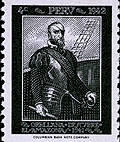 While it is true that none of the
group of twenty-one stamps dedicated to the Amazon openly
touches on the future development of this river, it is
not at all improbable that this subject may have been in
the minds of those who promoted their issuance. While it is true that none of the
group of twenty-one stamps dedicated to the Amazon openly
touches on the future development of this river, it is
not at all improbable that this subject may have been in
the minds of those who promoted their issuance.
In this era of
experimentation many novel ideas have been tried. The
direction and guidance of public thought is one
development of political science that has received much
attention. In the stimulation of national ideologies,
postage stamps have played an important and surprisingly
large part. World's Fairs, religious observances, and
national industrial opportunities have frequently been
depicted on postage stamps. On innumerable occasions
political philosophies have been epitomized in the
portraits of such heroes as Bolivar, San Martin,
Washington, Artigas, and Sucre. 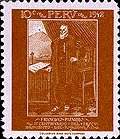
During the years 1940,
1941, and 1942 Ecuador, Peru, and Brazil dramatically
invited attention to the mighty Amazon through postage
stamps. In all three cases the four hundredth anniversary
of the discoveries of Gonzalo Pizarro and Francisco de Orellana have been
used as justification for these postal issues. Their
adventures constitute a series of the most dramatic
incidents in all of the sensational history of the
unfolding of the Western world.
In 1540 a substantial
Spanish population had already gathered in widely
separated localities of South America. The settlers,
largely conquistadors and adventurers, had a fair
conception of the general geographical characteristics of
the land to which the lure of wealth had drawn them.
Their ancient maps, black and yellow air mail stamp of
Ecuador, illustrate their fairly accurate concept of the
vast South American continent.
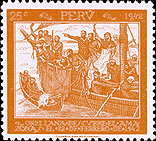 Prior to that time, in the year
1500, Vincente Pinzon, one of the Captains of the
original Columbus expedition, skirted the eastern shore
of this great "island," as he presumed it to
be. At a point close to the equator he fell upon a
mystery more baffling than any he had previously
encountered. The salty nature of the ocean had changed to
fresh water. The aimless tossings of its billows assumed
a slight current, directed toward no particular
destination but emanating endlessly from between two
points of land so widely separated that to his mind they
could not have been the opposite shores of a river. As
Pinzon sailed his ship westward between them he became
more perplexed than ever, for nowhere in the experiences
of Columbus, The Great Navigator, or the scientific
discourses of Toscanelli, or the fantastic writings of
Marco Polo, had the story ever been told of a body of
fresh water lying within or adjoining the great salty
ocean. After sailing westward for several days against
the increasing current, he christened the strange waters
with the name "Mar Dulce" and contented himself
with having it noted in his log, leaving the significance
of the strange experience to others. Prior to that time, in the year
1500, Vincente Pinzon, one of the Captains of the
original Columbus expedition, skirted the eastern shore
of this great "island," as he presumed it to
be. At a point close to the equator he fell upon a
mystery more baffling than any he had previously
encountered. The salty nature of the ocean had changed to
fresh water. The aimless tossings of its billows assumed
a slight current, directed toward no particular
destination but emanating endlessly from between two
points of land so widely separated that to his mind they
could not have been the opposite shores of a river. As
Pinzon sailed his ship westward between them he became
more perplexed than ever, for nowhere in the experiences
of Columbus, The Great Navigator, or the scientific
discourses of Toscanelli, or the fantastic writings of
Marco Polo, had the story ever been told of a body of
fresh water lying within or adjoining the great salty
ocean. After sailing westward for several days against
the increasing current, he christened the strange waters
with the name "Mar Dulce" and contented himself
with having it noted in his log, leaving the significance
of the strange experience to others. 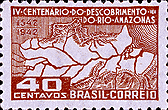
So incomprehensible was
the enigma Pinzon had presented that the "wise
men" of the old world demonstrated their wisdom by
remaining silent. As a result four decades and longer
passed before the world realized that Vincente Pinzon
had, in fact, achieved one of the greatest discoveries of
the New World. Pinzon and a whole generation of his
fellow men died without ever having realized that he had
discovered the giant of New World waterways, later named
the Amazon.
To this day, and perhaps
for all future time, however, the discovery of the Amazon
will continue to be accredited to another conquistador.
This capricious award of fame is no doubt attributable to
the more sensational and melodramatic story of Francisco
de Orellana and the manner in which he became associated
with the Amazon. In truth, it might be recorded that,
while Vincente Pinzon discovered the existence of the
river, it remained for Orellana to discover its greatness
and, vaguely, its course. Strangely, they approached the
river from opposite ends, Pinzon unknowingly having
entered its mouth and Orellana having traced its course
down the eastern slope of the Andes, beginning 3,000
miles from its mouth in the highlands of the Republic now
known as Ecuador.
The early seat of
Spanish authority and military power centered about the
Vice- Royalty of Peru where Francisco Pizarro, the
Viceroy, ruled with uncompromising authority. His fame
and success was to no small extent due to the loyal
prowess of his brother Gonzalo, and to his lieutenants,
Francisco de Orellana and Diego de Almagro. As the
dominant Pizarro's prestige rose, Almagro’s ambition
for recognition and reward increased, and as has so often
been the case where friends of unusual prowess vie,
disagreement soon arose. The Viceroy Pizarro knew but one
satisfactory course to pursue when his power was
challenged.
In 1538 he dispatched a
substantial force of his military strength under command
of his brothers Gonzalo and Hernando against Almagro, and
assigned an important military task to his trusted
friend, Francisco de Orellana. Their forces were large
and their equipment surpassed that of Almagro who
suffered defeat, and, after surrendering, the penalty of
death for his insubordinate challenge to the authority of
the Viceroy Francisco Pizarro. Gonzalo Pizarro was
rewarded for his successes by being named Governor of the
Province of Quito.
The military skill and
the daring of Orellana in warfare so pleased the Pizarro
brothers that the intrepid soldier received high praise
and was rewarded with the title of Governor's Lieutenant
General of the newly founded city of Santiago de
Guayaquil, situated west of the peaks of the Andes. There
he demonstrated that he was as proficient in civic
administration as he had been successful in battle.
Guayaquil, as a vassal city to that of the Viceroy,
prospered and grew.
The early Spanish
conquistadors, however, were not an agricultural people
content to establish a community and live on such
products of the land as its resources might offer.
Gonzalo Pizarro well recognized that fact and found
little difficulty in convincing his brother, the Viceroy,
that it would be well to organize a strong force to move
eastward to discover and take possession of the fabulous
wealth of El Dorado, the Man of Gold, and of La Canella,
the Land of Cinnamon. No difficulty was encountered in
recruiting a following to proceed on an adventure that
promised such rich reward. According to Indian report and
tradition, El Dorado possessed wealth in gold that knew
no bounds. The most menial utilities were made of the
precious metal that glittered and scintillated in the
brilliance of the ever present tropical sun. It came from
sources that were seemingly inexhaustible. El Dorado
alone knew of their locations. Then too, in the same
general direction as the abode of El Dorado, was the Land
of La Canella where the fragrance of cinnamon perfumed
the air with a deep, piquant, stimulating odor that
surpassed the exotic and aromatic incenses of Oriental
spice lands.
Toward the attainment of
these rewards awaiting mere taking by the Spaniards, the
adventurers rallied to the call of Gonzalo Pizarro.
Several thousands, including Indian servants, made ready
to follow the leaders appointed by the Governor, chief
among them being Francisco de Orellana and Gonzalo Diaz
de Pizarrro. With munitions of warfare, building
materials, food supplies in casks and bales, and even
livestock on the hoof, they finally got under way. Late
in February of 1541 the advance unit of the expedition
set forth.
By day they traveled
down paths of verdant grasses and at even tide paused in
a cool ravine to enjoy relaxation and a satisfying meal.
They gathered before open fires to revel in the
interpreted stories of their native Indian guides. Each
evening the Spanish adventurers relaxed to absorb further
and more exaggerated stories of the glittering golden
horde of El Dorado. As succeeding nightly camp fires were
lighted, the men were assured that the land of their
desire was but a few days further travel toward the
rising sun. Each morning they arose at dawn fired with
the certainty that the forthcoming day's journey would
bring them closer to El Dorado. In their enthusiasm less
consideration was given to the fact that food supplies
were diminishing than to the hope of reaching their
desired destination of gold. They appeared wholly
oblivious to the fact that the dense vegetation through
which they were forging their way offered no fresh
supplies of food and that animal life consisted largely
of snakes, lizards and ugly monsters that crawled on
their bellies.
One day, however, the
situation in regard to their lack of food stores dawned
on them with startling emphasis. They held a consultation
and it was decided that a brigantine was to be built
which, freighted with their heavier burdens of munitions
and cannon, was to move down the river to a point where,
it was told, supplies of fresh meats and vegetables were
to be found. There the heavier articles of their equipage
were to be left, along with some of the men. Food was to
be brought back on the return trip and then all were to
proceed onward again to the Golden Land of El Dorado.
The plan was excellent.
While the brigantine was being constructed of rough hewn
forest logs, further consultations were held as to which
of the Governor's lieutenants was to captain the ship.
Gonzalo Diaz de Pizarro was the only one seriously
considered beside Francisco de Orellana. A decision was
quickly reached, the former being assigned to remain with
Gonzalo Pizarro and the main contingent of the soldiers,
while Orellana accepted the honor and the responsibility
of leading the contingent about to go forward for food.
In ambitiously accepting
that assignment Orellana unknowingly was facing the
turning point of his life. As a result of this new phase
of his adventure, the high regard of the Pizarros, both
Viceroy and Governor, was to turn from admiration to
vindictive hatred, and the former praise he had received
as soldier and as chief of the City of Santiago de
Guayaquil was to be succeeded with charges of
insubordination, treason, and treachery. As a matter of
actuality his reputation became sullied with the most
unkind and uncomplimentary aspersions which endured for
centuries after he had died.
Orellana, born in 1511
in the town of Trujillo, Province of Esremadur in Spain,
was the son of a prominent family. He was hardly more
than a boy when he went to sea. In the service of
Francisco Pizarro, to whom he was distantly related, he
found a place among the early conquistadors who
introduced the blood of Spain into the New World. During
early life, in one of many hand-to-hand battles he lost
one of his eyes, which added color to the infamous title,
''the One- Eyed Traitor," by which he was long known
in the records of history–accepted as authentic
until the end of the nineteenth century.
In 1894 Jose T. Medina,
a deep student of the source materials of writings long
accepted as authoritative, completed a research that had
engaged his major attention for a long period of years.
He had taken issue with the record "created" by
Jiménez de la Espada some three hundred years before,
while lingering reflections of the old Pizarro-Orellana
feud still persisted. Medina's views now appear not only
to warrant favor, but to possess a logical sequence of
factual data that justifies the honor and prestige
restored and rightfully belonging to Francisco de
Orellana.
On December 26, 1541,
amid salvos of good wishes and the cheers of his
comrades, Orellana captained the brigantine his fellow
adventurers had built and started eastward on what was to
have been a mission of mercy in finding food and
returning it to his companions. He planned to move
downstream with the aid of his sails and the mild
current, and then to return. The stream broadened as he
proceeded, the waters took on a more powerful movement,
and the jungle land became more dense, but neither
villages nor edible vegetation greeted the ever watchful
eyes of Orellana and his men.
From time to time
occasional small bands of jungle natives greeted him
through unfamiliar signs and incomprehensible mouthings.
Through them Orellana was led to believe, or chose so to
interpret their messages, that supplies of food were to
be found ahead after another day of travel. But as each
day waxed from noon to night, the quest lured him further
down stream. The current increased, the river widened,
and the waters, fraught with cataracts and rapids,
rendered progress more dangerous with every hour. Each
day his surroundings changed even the character of the
natives differed. In place of friendly Indians he met
with a savage tribe whose greetings were conveyed by
arrows with hardened tips bathed in the poisons of the
jungle. They were an odd lot; according to the record of
the historian Carvajal, they had fair skins, long blonde
hair, and wore tunics that reached to their knees. As a
result of this record, however clothed with imagination
it may have been, these unfriendly natives were referred
to as the feminine Amazon warriors of the New World.
Battle with them and even flight from their missiles
called for all the skill Orellana could command.
Orellana’s food
stocks ebbed and then disappeared entirely. The captain
of the mission of mercy in search of food for his
companions upstream began to realize that his temporary
assignment had, for the time being, assumed less
importance than his own growing predicament of danger.
The increasing river current, the savage natives, and his
crew of men whose morale had reached its lowest ebb with
cases of scurvy and other diseases prevalent, constituted
problems that had changed the whole world for Orellana.
In heart and mind he had not forgotten Gonzalo Pizarro
and the mission he had been called on to perform, but as
a practical matter there was no course for him to pursue
other than onward into the indefinite spaces ahead at the
mercy of the current and the winds. Had it been possible
for Orellana to return to Pizarro, it was obvious that
there was no point in taking that chance for the single
purpose of reporting a failure to accomplish his
objective.
Onward with the current
Orellana willingly or otherwise plunged, finding the task
of keeping the keel of his ship beneath him as much as he
could manage. Torrential rains further handicapped his
better management of the brigantine, the rains beating
upon its deck with such force that the forecastle was not
visible from the stern of the ship. Days followed weeks
with a monotony varied only in the type and character of
changing dangers. Time had lost its significance,
direction had no meaning, even a destination was of less
interest to Orellana than the ever present consequences
of hunger. Starvation, scurvy, and death all took their
toll as the nameless brigantine tossed and lurched its
way down stream to an unknown destination.
St. Louis Day late in
August of 1542 dawned and unexpectedly proved to be the
end of a voyage auspiciously begun eighteen months
before–a voyage that was intended to have lasted but
two weeks. Orellana and his men had reached the Great
Ocean, having traveled some three thousand miles eastward
from the Andes. The original objective of their mission
had long since been forgotten yet it was, according to
Medina, in this way that they brought to an end their
navigation and experience which had been entered upon
unintentionally and turned out to be so extraordinary
that it is one of the greatest things that ever happened
to men.
Orellana's original
objectives of finding El Dorado and La Canella were never
realized. His secondary mission of obtaining food for his
companions was likewise never accomplished. For this
latter failure he was censured throughout the realm of
the Pizarros as having been a traitor in deserting his
companions in the hour of their greatest need. In Spain,
after the full extent of Orellana's journeys became
known, he was acclaimed a hero on whom great honors were
bestowed. But his triumph was transitory. At the height
of his fame he was sent to Colombia to investigate a
difficulty which had arisen between certain of the
Spanish officials stationed there. After familiarizing
himself with the situation he made the unfortunate error
of ordering the arrest and imprisonment of several
members of the "Audencia." The Council of the
Indies in Spain, on reviewing the situation, disapproved
of Orellana’s action, and in turn, ordered him to
prison where he died a short time later. So destitute was
the great voyager, that it became necessary for someone
else to meet the expenses of his funeral.
Despite the misfortunes
of his own life, Orellana is today credited with the
distinction of having been the first man to have
navigated the entire length of the Amazon, thus bringing
recognition of its immensity to the world. His reports
stimulated a series of exploratory voyages to and up the
river and its several tributaries. Among them the most
dramatic were those of Lope de Aguirre and, later, that
of Pedro de Teixeira. Despite these explorations, the
Spaniards acquired only a vague idea of the magnitude of
the Amazon, its tributaries and drainage basin. This is
evidenced by their crude maps, now obsolete, several of
which are to be seen on the recent postage stamps of
Ecuador and Peru. A fuller picture of the vast reaches of
the Amazon, at least insofar as the Brazilian basin is
concerned, is to be noted on a 1943 brown map stamp of
Brazil released by Brazil in 1943.
The increased needs of
world markets for many basic materials and substitutes
for others, so sternly realized in connection with the
prosecution of World War II, has brought a distinct
change to the Amazon Basin. The great rubber industry has
reawakened, embracing not alone the agricultural phases
of cultivation but likewise the subject of manpower
coupled with the endless human needs of food, shelter,
and clothing for the workers and their families, schools
for their children, health and sanitation facilities, and
the equally great problem of transportation by land, sea,
and air. Rubber is said to have been indigenous to the
Amazon valley, although later cultivated in the East
Indies and Africa where it gained great commercial
prosperity. From present indications it would appear that
the Era of Rubber in the Amazon Valley is about to begin.
Quinine, a product of
the bark of various species of the cinchona tree, is
likewise a native of the Ecuadorean and Peruvian basins
of the Amazon. The unprecedented movement of men to
tropical climates in connection with the pursuit of World
War II, so stimulated the need for the medicinal powers
of quinine that the cultivation and treatment of cinchona
trees of the Amazon valley have received an impulse
greater than ever before. Woods of a wide variety,
fibers, tin, manganese, and other natural resources in
quantities and grades still unknown lie dormant in the
huge Amazon Basin covering an area larger than that
portion of the United States east of the Mississippi
River. Many species of native flora of the Amazonian
regions still remain subjects of chemical and commercial
experimentation and exploitation such as the vegetable
ivory trees, the babassú nuts and the carnauba palm.
This latter species, which flourishes in the dry regions
of the northeast has already received considerable
attention. In regard to it Professor Fred A. Carlson of
the Ohio State University has written in his Geography
of Latin America:
The root is
depurative and is widely used in treatment of blood
diseases. From the bark is prepared a meal which is
highly prized. The trunk furnishes a wood employed in
rough timbering. The fruit is an excellent food for
animals, and when ripe, has a soft, dark, lustrous
sweet pulp which is delicious either raw or made into
a conserve. Around the fruit is a shell five inches
in diameter, which when roasted, is made into a drink
resembling coffee, and which yields an illuminating
oil. From the surface of the young leaves comes the
famous carnauba wax which is widely used in
phonograph disks, in cinema films, in insulation for
cables and in candles.
To science the great
Amazon River and its far-reaching Basin still remain to
be discovered with a view to a fuller use of their
abundant natural wealth. As Vicente Pinzon in 1500
discovered the existence of the river, and Orellana in
1542 its length and course, so, even today, after a span
of more than four centuries, there remains for discovery
through the advanced sciences of our generation, a
multitude of practical uses for the natural assets of the
Amazon Basin.
|

